#fennel seed oil
Explore tagged Tumblr posts
Text

Fennel Seed Oil
Fennel seed oil and its benefits date back to the ancient time of Egyptians and Romans, they used this oil for its spiritual, emotional and medical support. Traditional uses of this oil differ from person to person and as per the requirement of the body. There are various oils that have different benefits and that add a lot to your body and to the normal working of your system. Fennel seed oil is one of these special oils which are extracted of a flowering plant species that is highly beneficial for the users. Earlier, people were used to use the oil for spiritual purposes now days it is used to balance your body and it’s functioning. https://www.meenaperfumery.com/essential-oils?product_id=544
0 notes
Text
Healthy Essential Oils You Need In Your Kitchen

HEALTHY ESSENTIAL OILS YOU NEED IN YOUR KITCHEN
Essential oils have permeated every household due to the unexpected rise of the "natural lifestyle" idea. Everyone is familiar with their outward use, but not everyone is aware of the proven advantages of these oils when ingested.
Essential oils are those undiscovered jewels that have constantly been utilized in the food and drinks sector but have received least attention. They are also used by some premium restaurants to offer you a variety of flavors onto your plate. These charming little bottles may have caught your eye as you browsed the store's shelves, but you likely passed them by or grabbed one for your skin or hair instead.
The next time you see them, you should be mindful of how these oils could improve your culinary abilities. Whether your recipes are tangy or sweet, essential oils can expand your menu options with a touch of elegance.
So Let’s Delve In And Explore The Top 6 Incredible Essential Oils Ideal For Your Kitchen
1) Ginger Oil

Image source: freepik.com
An energizing and best when heated, Ginger oil is frequently used in cooking to enhance flavor in worldwide cuisines. This oil is known for its natural soothing properties which helps diminish aches and pains along with toxin removal and digestion ingredients. In India, it is the best ingredient to ease respiratory congestion.
2) Cardamom Oil

Cardamom is known to be the queen of all spices. Alongside its brilliant uses in daily life like soothing dental discomfort it is also serves as a brilliant spice oil for your daily kitchen needs. A perfect home remedy for many digestive challenges, just by adding few drops in your Indian specialty meals you can experience a calming as well as relaxing effects that can enhance breathing.
3) Turmeric Oil:

Turmeric oil not only aids in the improving and boosting immune but also has other massive natural positive outcome. Over and above possessing antibacterial and antiseptic agents it can act as a great home remedy for soothing minor burns, cuts, bites, and bruises. Due to its Ayurveda ingredients it aid as a great oil which enhances skin health. When consumed often in your diet you’re sure to have cleansing, clarifying, smooth, calming, invigorate, and brighter skin texture. Its warm, rustic, and spicy aroma is exhilarating and calming at the same moment. From roasted veggies to sweet potato mash, you can add it to anything that requires a taste lift.
4) Black pepper Oil

Image source: freepik.com
With great external and internal merits, black pepper essential oil can be used in cooking to linger your taste buds with optimal sharpness. An extra feather in the cap is that black pepper oil possesses anti-arthritic and anti-rheumatic properties. Hence, boosting blood circulation and helps manage arthritis and rheumatism efficiently.
5) Fennel Seed Oil:

Fennel seed also widely known as Saunf in Hindi, has magical digestive properties making it a must have essential oil in your kitchen. The advantages of fennel seed essential oils promote the release of digestive enzymes and fluids, which calms a painful tummy. Best added to a plate of green vegetables, fennel seed oil is a perfect dressing to your salad enhancing taste and create a delectable flavor combination.
6) Cumin Oil:

Image source: pexels.com
Cumin essential oil is a prevalent spice that may be used to improve multiple cuisines. For hot cumin flavoring, add one to three drops of cumin essential oil to sauces, soups, and cuisines to enhance flavors. The oil extracted from cumin seeds has proven to be an effective larvicide and antiseptic agent. The oil claims to kill strains of bacteria that are resistant to other antiseptics. Researchers believe that cumin could help kill harmful bacteria that's trying to attack your immune system.
Choose to stay healthier with our wide variety of essential oils.
Quick Tips for cooking with Essential Oils:
Put a toothpick into the essential oil if you only need a tiny bit, and then twirl it around in your dish.
Cook only with stainless steel or glass, as essential oils tend to dissolve plastic.
Essential oils will remain longer if they are stored in a cold, dark place.
Key take away
The benefits of essential oils are enormous. Be it for external use or for consumption, its magical properties are sure to make you feel healthy and nourished.
Happy cooking!
0 notes
Photo

spinach and artichoke pizza with cheesy bread crust · half baked harvest
#spinach and artichoke pizza with cheesy bread crust#spinach and artichoke pizza#pizza#spinach#artichoke#cheesy bread crust#crust#bread#butter#garlic#basil#oregano#thyme#fennel seed#olive oil#baby spinach#mozzarella#cheese#fontina#parmesan#marinated artichokes#artichokes#food
149 notes
·
View notes
Text
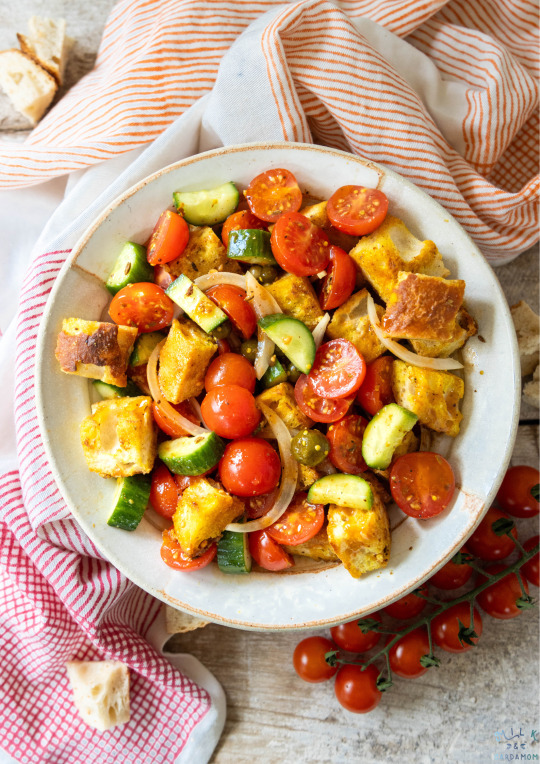
Desi-Style Panzanella Salad (Vegan-Adaptable)
opt for plant-based ghee or coconut oil
#vegan#appetizer#lunch#salad#panzanella#cucumber#tomatoes#onion#kerda#croutons#bread#vegan ghee#turmeric#cumin#fennel seeds#coriander#tomato achaar#vinegar#olive oil#black pepper#sea salt
85 notes
·
View notes
Text
Lemon and Rosemary Chicken and Cassava Stew

This Lemon and Rosemary Chicken and Cassava Stew is both hearty and bright, perfectly comforting and soothing on a cold Winter night! Happy Wednesday!
Ingredients (serves 3):
1 large cassava
2 tablespoons olive oil
2 fluffy sprigs Garden Rosemary
1 1/2 lemons
1/2 teaspoon fennel seeds
3 chicken thighs
1/2 teaspoon fleur de sel or sea salt flakes
1/2 teaspoon freshly cracked black pepper
1 onion
2 bay leaves
1 large garlic clove
1 heaped teaspoon coarse sea salt
1/2 teaspoon freshly cracked black pepper
1 litre/4 cups water
Bring a large pot of water to the boil.
Meanwhile, thoroughly peel and rinse cassava, before cutting into thick slices.
Rinse cassava slices again, under cold water.
Once the water is boiling, add cassava slices, and cook, half an hour. Drain, and allow to cool. Set aside.
Heat olive oil in a large pot over medium-high heat. Add Rosemary sprigs, and fry, 30 seconds.
Grate in the zest of a whole lemon, and fry, 30 seconds more.
Stir in fennel seeds. Cook, another 30 seconds.
Add chicken thighs, skin-side down, and brown, about 4 to 5 minutes on each side. Season with fleur de sel and black pepper.
Once well-browned, transfer chicken thighs to a plate, leaving the fat in the pot; set aside.
Peel and finely chop onion. Stir into the pot, and sweat, a couple of minutes until softened. Add bay leaves.
Peel and grate in garlic clove. Cook, another minute.
Thoroughly squeeze in the juice of the whole lemon.
Return chicken thighs, along with their resting juices, to the pot.
Cut cooled cassava into small bites, and stir into the pot, coating well in oil, herbs and juices.
Season with coarse sea salt and black pepper.
Finally, stir in water, and bring to the boil.
Once boiling, reduce heat to medium, and simmer, another 30 minutes, until chicken is cooked through and cassava is al dente. Remove from the heat, and squeeze in the juice of the lemon halve.
Serve Lemon and Rosemary Chicken and Cassava Stew very hot.
#Recipe#Food#Lemon and Rosemary Chicken and Cassava Stew#Lemon and Rosemary Chicken and Cassava Stew recipe#Chicken Stew#Chicken Stew recipe#Chicken Thighs#Chicken and Poultry#Cassava#Olive Oil#Lemon#Lemon Zest#Lemon Juice#Fresh Lemon Juice#Rosemary#Garden Rosemary#Fennel Seeds#Bay Leaves#Onion#Garlic#Fleur de Sel#Coarse Sea Salt#Black Pepper#Black Peppercorns#Water#Stew#Stew recipe#Soup and Stew#Winter Warmers#Winter recipe
2 notes
·
View notes
Text

Braised Lamb Shanks with Fresh Corn Blue Cheese Polenta
For the Lamb:
4 lamb shanks (about 3 lbs.), trimmed
1 Tbsp. kosher salt
1 tsp. freshly ground black pepper
2 tsp. minced fresh rosemary
1 tsp. coarsely ground fennel seeds
4 garlic cloves, 1 grated, 3 minced
2 Tbsp. olive oil
1 large onion, minced
1 Tbsp. flour
1 tsp. paprika
½ tsp. crushed red pepper flakes
1 cup canned diced tomatoes
¼ cup dry white wine
2-3 cups chicken broth
For the polenta:
2 cups water
2 cups milk
2 Tbsp. butter
½ tsp. salt
1 cup polenta
kernels from 3 ears fresh corn (about 3 cups)
½ cup crumbled blue cheese
Place the lamb shanks on a rimmed baking sheet. Stir salt, black pepper, minced rosemary, ground fennel seeds, and grated garlic together in a small bowl, then massage into lamb. Cover and let sit at room temperature for 1 hour, or refrigerate overnight.
Preheat the oven to 350°F. Heat the olive oil in a large dutch oven over medium heat, add onions and saute until golden, about 10 minutes. Add minced garlic, flour, paprika, and red pepper flakes and stir vigorously to distribute flour. Cook until mixture becomes dry, about 1 minute, then add tomatoes and wine. Simmer, stirring frequently, until mixture begins to thicken and tomatoes are breaking down, about 10 minutes. Stir in 2 cups of the chicken broth and simmer for about 5 minutes. Season to taste with salt and pepper. Add lamb shanks to pot in a single layer, pushing them down into the sauce. If necessary, add additional chicken broth so that the shanks are about 3/4 submerged
Roast, uncovered, for 30 minutes, then use tongs to flip the shanks over and roast for another 30 minutes. Then, cover the pot and cook, turning the shanks occasionally, until the meat is falling off the bone, about 45-90 minutes. Remove from oven and skim fat off the surface. Let shanks rest in liquid for 20 minutes before serving.
For the Polenta:
Bring the water, milk, butter, and salt to a boil in a medium saucepan. Gradually add the polenta to the boiling liquid, whisking as you do so. Once all the polenta has been added, lower the heat to low, and cook, stirring continuously, until the polenta is thick and creamy, about 10-15 minutes. Add the fresh corn kernels, and cook 2 minutes longer. Season to taste with salt and pepper, and remove from heat. Serve hot, with blue cheese crumbled over each bowl.
#angelkin#food#dinner#spicy#meat#lamb#black pepper#rosemary#fennel seed#garlic#olive oil#vegetable#onion#flour#paprika#crushed red pepper#tomato#alcohol#wine#milk#butter#polenta#corn#cheese#dogkin#faekin#ghostkin#herokin#moutainkin#pantherkin
6 notes
·
View notes
Text



guy whose work is letting hir experiment with the challah recipe <3
#tuesday is my test bake day (:#yes my earring is a challah braid that is the sole reason ive attached a selfie i love my bread earrings#my face#bread#it tastes SO good#different than last week and tbh i think better#food tw#i lowered the hydration n swapped the honey for sugar bc its cheaper </3#which tastes Different like theyre 2 different results its really neat!#my manager thinks it needs more sweetness but i kinda disagree but she is the boss#im gonna test some inclusions/stuff this weekend bc ive had ummm#sesame seed and poppy seed and orange cranberry all of which are pretty good#but the olive oil is Such a good choice#i think it could use another egg but i dont know if i'll get away with it lsdkjfklds#my coworker who i love suggested fennel?#and my manager is gonna get some golden raisins for me to try next tuesday which would mess with the hydration a lil bit#but the texture was So good#that lil center beast is the cinnamon sugar which would be neat to just fully replace bc the dough is gonna be a lil sweet#the recipe i use at home is honey#jackie is suggesting some to me (: n i may look up some stuff
14 notes
·
View notes
Text
Fennel and Black Pepper Ice Cream
Via Tenderheart. 1 small fennel bulb (about 7 oz/200 g), finely sliced, fronds reserved to serve 1 tsp fennel seeds 1/2 tsp freshly ground black pepper, plus more to serve one 14-oz (395 g) can sweetened condensed milk (regular or vegan) 1 cup (240 ml) heavy cream or vegan coconut cream 1 tbsp extra-virgin olive oil, plus more for drizzling Place all the ingredients in a high-speed blender…

View On WordPress
0 notes
Text
[ Original Twitter Thread by @/beelektra ] - Not by Magz, am not Palestinian
Palestinian Foods. (long post)
Quote:
"🧵 Thread of Palestinian desserts I've grown up around and seen A thing I'd like to add is that I just like to share my culture! I do not want to spread the narrative that our culture is dying, I only want people to see our foods and traditions 🇵🇸
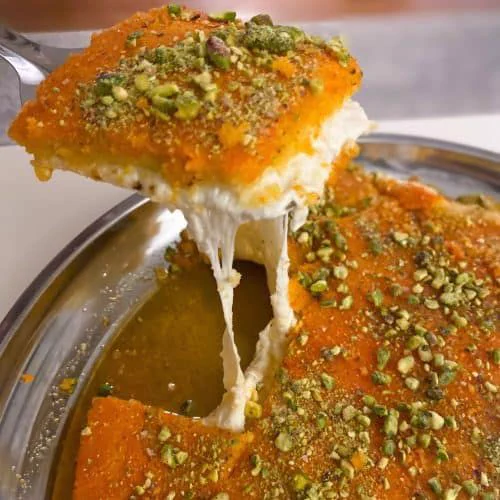
"As mentioned in the last post, we have knafeh (or kunafa), a buttery dessert made with shredded pastry layers such as cheese and other ingredients like pistacho or cream!"

"Burbara; which comes from Saint Barbara, fun fact! It's a soup dessert that mainly consists of barley, licorice spices, anise, cinnamon, and fennel powder This is a dessert usually many Christian families have to celebrate Saint Barbara, which is December 4th!"
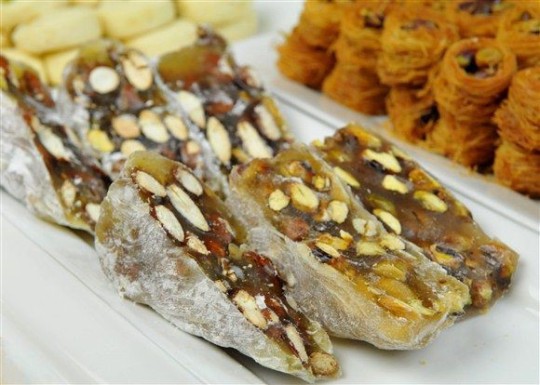
"Malban, which resembles a fruit jelly! Made from starch and sugar Specifically, it's made with grape molasses, thickened with starch and flavored with rose water, and stuffed with almonds (or other nuts including walnuts, treenuts, and peanuts)"
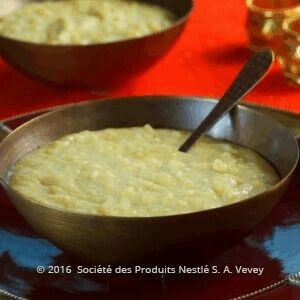
"Khabeesa is simply just a pudding made with grapes, but you prepare it by mixing the grape juice with semolina and nuts + seeds."
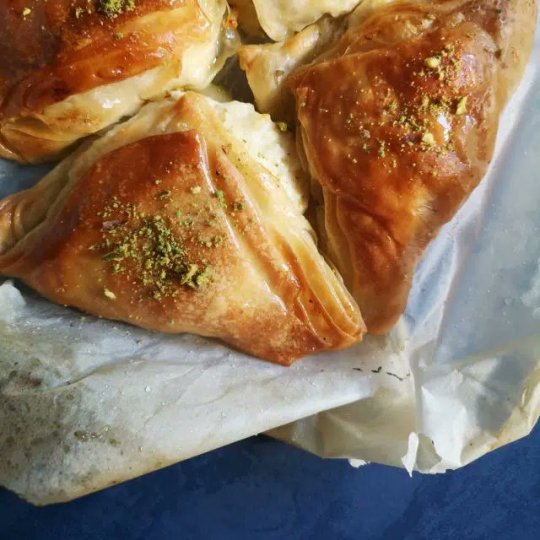
"Mtabbak or mtabba, a crispy dough stuffed with crushed walnuts. It also contains cinnamon, sugar, and syrup. Photo credits go to Bartek Kieżun on Instagram"
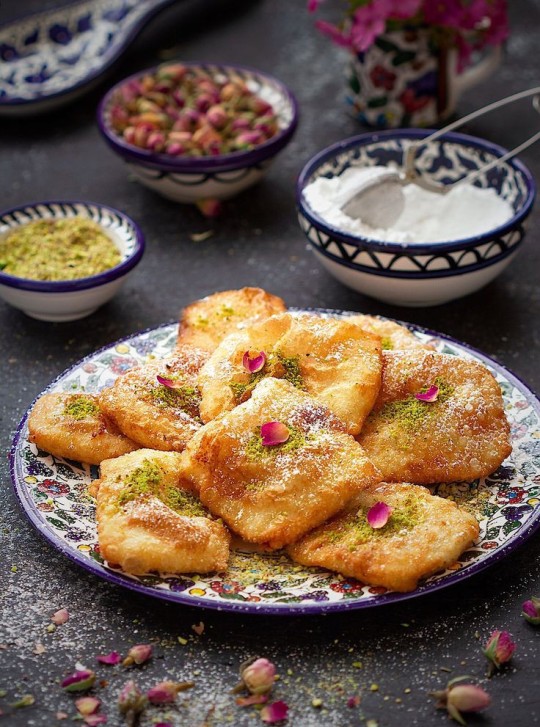
"Tamriyeh, a fried pastry filled with semolina pudding, scenter with mastic and orange blossom water, and topped off with powdered sugar"

"Ka'ak bi Tamer, which are date paste filled cookies with cinnamon! A dessert made for Eid-Alfitr. It's topped with nigella seeds, and the cinnamon-spiced date paste is the most important part of it all– you can eat it on its own or have it with coffee"
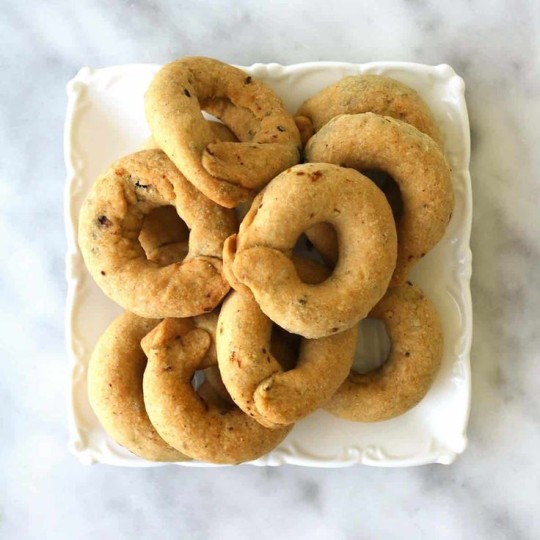
"+ Ka'ak Asawer, another dessert that can be prepared for Eid-Alfitr. It's translated to bracelet cookies, and they use date paste, flour, anise seeds, sugar, ground cinnamon, and olive oil"
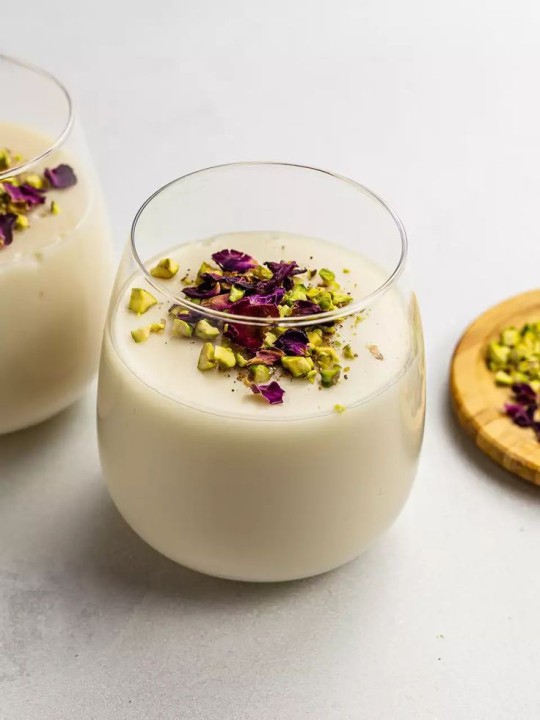
"Muhallebi or mahalabia, a milk pudding that's made with sugar, corn starch, and fragrant flavorings! It's topped off with nuts, pistachos, and almonds and sprinkled with ground cinnamon or shredded coconut"
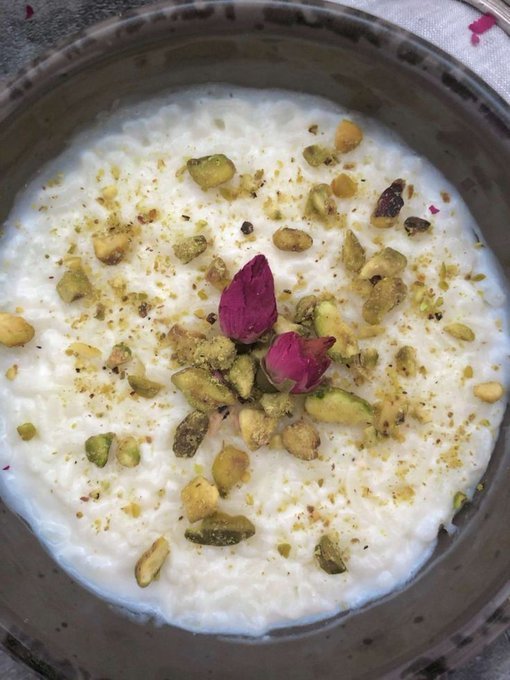
"Rice pudding, which is a common dessert in Palestine, and it's your choice to top it off with nuts or not"
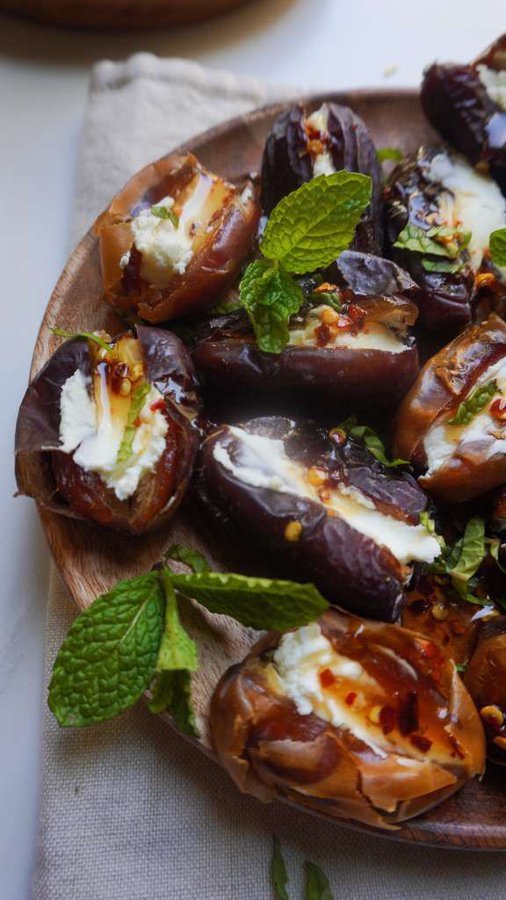
"Stuffed dates, using medjool dates and cracking them open to be stuffed with goat cheese and pistachios– but you're free to add anything else"

"Ma'amoul, a buttery crisp cookie primarily made of farina and can be stuffed with (spiced) dates, walnuts, or pistachios. This is another Christian dessert made by Palestinian mothers during the week of Easter Sunday."
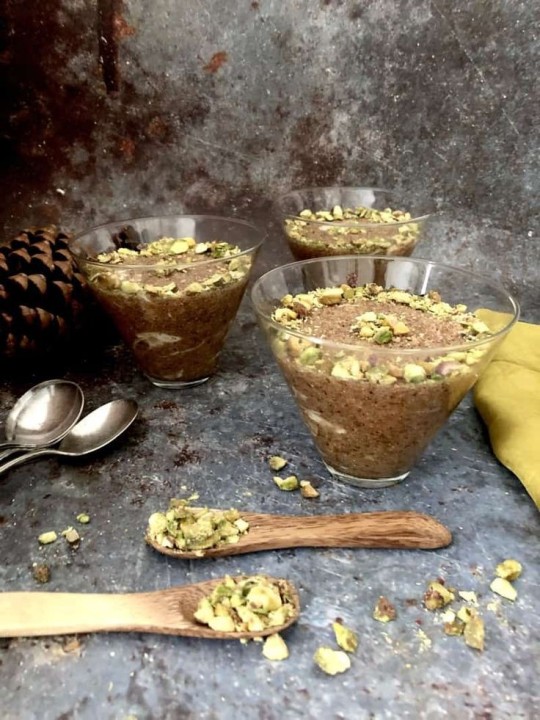
"Halawit Smid, a farina based dessert with added sugar and unsalted cheese. It's preferably served fresh"
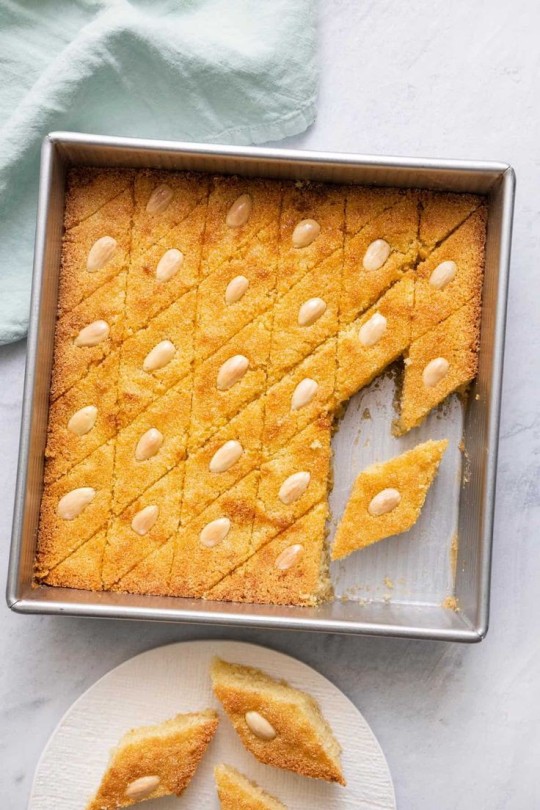
"Namoura cake, aka harissa dessert! It's made with semolina or farina flour, and then topped off with syrup once baked"
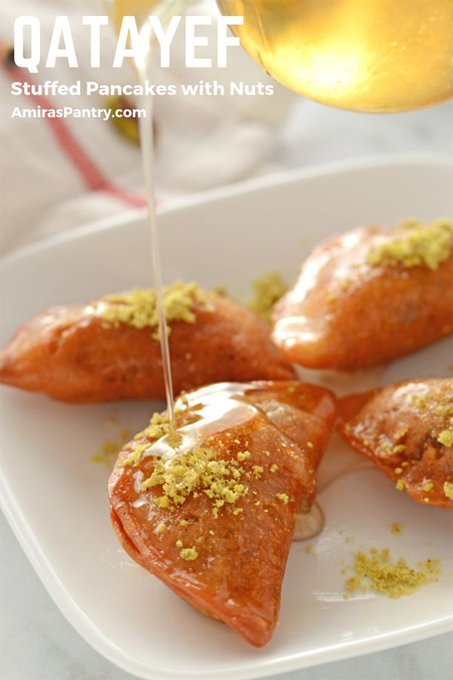
"Qatayef, which is eaten during the month of Ramadan. It's made of farina, flour, water, and yeast blended together– the process is pretty similiar to making pancakes, but only one side is cooked"
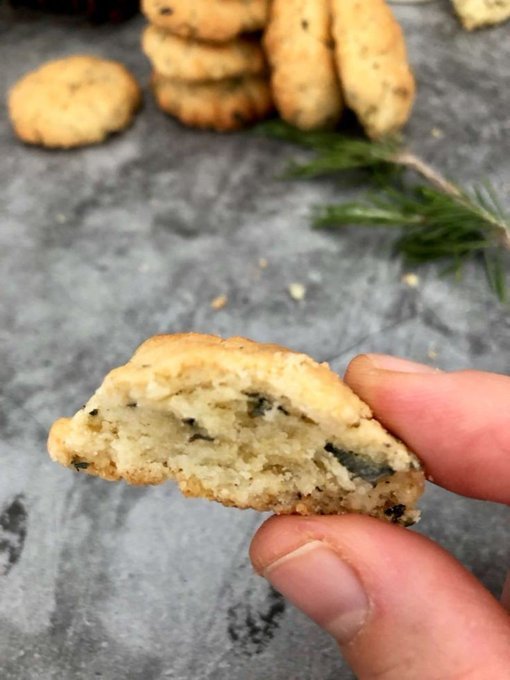
"Since I've mentioned using zaatar for a lot of things, I recently just discovered this but– there's also things such as zaatar cookies!! It's just as implied that the cookies are filled with zaatar, I'd be so willing to make this on my own"
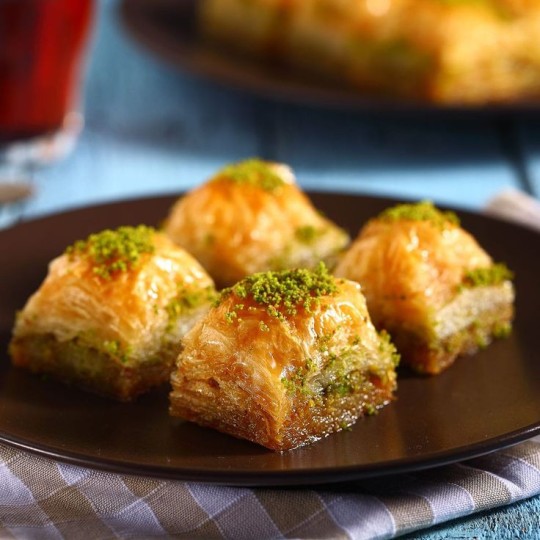
"Baklava, made from phyllo pastry dough, butter, nuts, basil, and a sweet honey syrup"
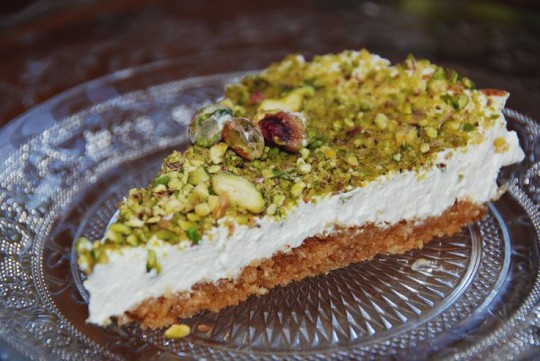
"Aish el saraya, arabic version of a bread pudding. It's basically a layered bread, where it starts from the bottom, then covered with a sweet syrup, cream, and crumbled pistachios."
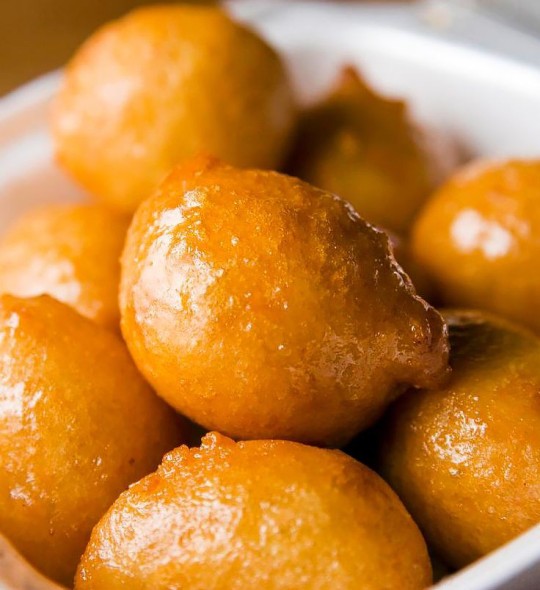
"Awwami, it's defined as "crisp donut ball" in English. It's a deep fried dough ball coated with sesame seeds, and dipped in cold syrup water."
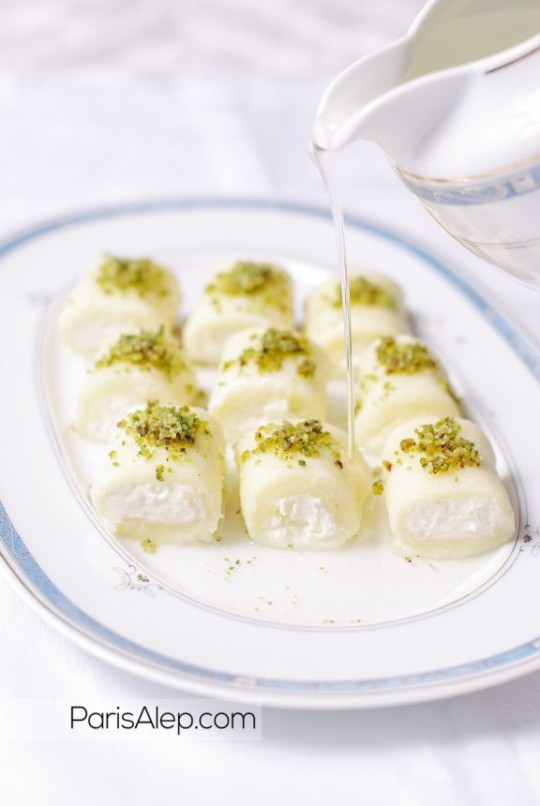
"Halawet el Jibn, a sweet cheese dessert rolled with custard, heavy cream, drizzled rose water + syrup, and garnished with nuts."
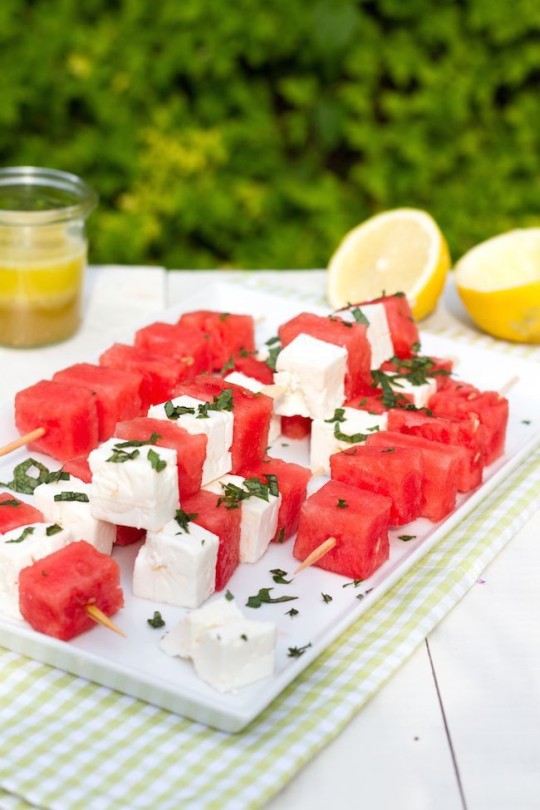
"Lastly, I'd like to add watermelon and cheese– for me, it's like,,,, bittersweet!!! You should totally try it and we also have this during Ramadan"
"Well, that's all I can think of for Palestinian desserts! Here's the first part for general foods, I know I did make a promise for part two
I hope you guys liked this thread, and if you have any opinions please feel free to quote tweet anything on here if I made a mistake, feel free to correct me, it's always appreciated P.S if you're a zionist commenting here I really don't care, just scroll, I'm sharing my culture
One LAST thing. if you want any of the recipes from here, check out this website, the creator (Wafa) shares so many wonderful traditional Palestinian dishes."
[End Quote]
7K notes
·
View notes
Photo

Fish - Tasty Tuna Steak Slices of seared tuna are topped with fennel-seasoned baby bok choy and red bell pepper.
0 notes
Text
Magical Oil Recipes - Baneful Edition

For anyone looking to brew up a potion with a less-than-friendly bent, here are some recipes I've created that you might find useful.
To prepare them, blend the ingredients in such proportions as feels correct for your purposes (or as supplies allow). Use dried material except where indicated. Place a few spoonfuls in a mason jar with a screwtop lid and fill the jar with a bland oil of your choice. (Vegetable oil of the sort you would buy for cooking works fine.) Screw the lid on tightly and shake well to combine, then leave the jar in a dark dry place for 2-4 weeks to steep.
Once steeped, prepare a clean storage bottle (also with a secure lid) and label with the type of oil and the bottling date. Strain the oil through paper towels or cheesecloth to remove the plant material, then bottle immediately. Store away from sunlight and heat for up to one year. Use for spellwork as you see fit.
(Please note that NONE of these potions are meant to be taken internally by any means. Observe all proper safety measures related to glass, fire, and potentially harmful plants as necessary during preparation.)
*- Ingredient is potentially harmful if inhaled or ingested. **- Ingredient should not be used or handled if you are pregnant or nursing.
All-Purpose Hexing Oil For general hexing, cursing, and baneful magic.
Dried Chili Pepper
Fresh Lime Peel
Lemongrass (dried or fresh)
Rusted Nail (place in bottle with finished oil)
All-Purpose Hexbreaking Oil For general negation of baneful spells cast by oneself or others.
Agrimony**
Cinquefoil
Fennel
Vervain
Solomon's Seal Root (place in bottle with finished oil)
Backhanded Blessing Oil For blessings that are anything but benevolent.
Burnt Cinquefoil
Bay Leaf
Pine Needles
Bayberry Root NOTE: Prepare as you would a blessing oil, then twist the blessing into a curse, i.e. May You Get Everything You Deserve.
Done in the Dark Concealment Oil For secrecy, confidentiality, and general deception.
Juniper Berries
Licorice Root
Black Hemp (Dogbane)
Ferns or Dried Seaweed Note: For the final ingredient, use whichever is easier to obtain. Both bracken and seaweed work well for basic concealment spells.
Eye of Newt Disruption Oil For disrupting and confounding magical efforts against you.
Black Mustard Seeds
Bloodroot**
Nettle Leaf
Garlic (1 clove, bruised)
No Rest For The Wicked Hexing Oil For punishing one's enemies.
Chili Pepper (any)
Horseradish Root
Cramp Bark
Bayberry Root
On Your Own Head Retribution Oil For counter magic and revenge hexes.
Elderberries*
Bloodroot**
Devil's Shoestring**
Vetiver
Tangled Shoelaces Binding Oil To impede someone's ability to move or act against you.
Pine Needles
Devil's Shoestring**
Scullcap**
Coffee Grounds
Iron Nail in master bottle
Wicked Witch Heavy-Duty Cursing Oil For occasions when a regular-strength hex just won't do.
Wormwood* **
Ghost Chili Pepper (or the hottest chili you can get)
Lemon Seeds
Lobelia* Note: Use With Extreme Caution And Cover Your Ass.
Witchbane Warding Oil For repelling and countering harmful spells.
Bay Leaves
Elderflower
Star Anise
Birch Bark
Should the reader require supplies, I recommend the following:
Penn Herb Company
Starwest Botanicals
Bulk Apothecary
Mountain Rose Herbs
Specialty Bottle
Image Credit - Shaiith
All recipes are (c) 2017 Bree NicGarran, published in Pestlework: A Book of Magical Powders & Oils. Please check out the book if you would like more recipes.
If you’re enjoying my content, please feel free to drop a little something in the tip jar, tune in to my podcast Hex Positive, or check out my published works on Amazon or in the Willow Wings Witch Shop.
#witchblr#witchcraft#curses#baneful magic#potions#witchy things#I'll see your Threefold Law and raise you an I'm Not Wiccan And I Don't Give A Fuck
323 notes
·
View notes
Text
September 2024 Witch Guide
New Moon: September 2nd
First Quarter: September 11th
Full moon: September 17th
Last Quarter: September 24th
Sabbats: Mabon- September 22nd
September Harvest Moon
Also known as: Autumn Moon, Child Moon, Corn Harvest Moon, Falling Leaves Moon, Haligmonath, Leaves Turning Moon, Mating Moon, Moon of Brown Leaves, Moon When Dear Paw the Earth, Rutting Moon, Singing Moon, Wine Moon, Witumanoth & Yellow Leaf Moon
Element: Earth
Zodiac: Virgo & Libra
Nature spirts: Trooping Faeries
Deities: Brigid, Ceres, Chang-e, Demeter, Freya, Isis, Depths & Vesta
Animals: Jackal & snake
Birds: Ibis & sparrow
Trees: Bay, hawthorn, hazel & larch
Herbs: Copal, fennel, rye, skullcap, valerian, wheat & witch hazel
Flowers: Lily & narcissus
Scents: Bergamot, gardenia, mastic & storax
Stones: Bloodstone,carnelian, cat's eye, chrysolite, citrine, iolite, lapis lazuli, olivine, peridot, sapphire, spinel(blue), tourmaline(blue) & zircon
Colors: Browns, dark blue, Earth tones, green & yellow
Issues, intentions & powers: Confidence, the home, manifestation & protection
Energy: Balance of light & dark, cleaning & straightening of all kinds, dietary matters, employment, health, intellectual pursuits, prosperity, psychism, rest, spirituality, success & work environment
The full Moon that happens nearest to the fall equinox (September 22nd or 23rd) always takes on the name “Harvest Moon.” Unlike other full Moons, this full Moon rises at nearly the same time—around sunset—for several evenings in a row, giving farmers several extra evenings of moonlight & allowing them to finish their harvests before the frosts of fall arrive.
• While September’s full Moon is usually known as the Harvest Moon, if October’s full Moon happens to occur closer to the equinox than September’s, it takes on the name “Harvest Moon” instead. In this case, September’s full Moon would be referred to as the Corn Moon.
This time of year—late summer into early fall—corresponds with the time of harvesting corn in much of the northern United States. For this reason, a number of Native American peoples traditionally used some variation of the name “Corn Moon” to refer to the Moon of either August or September.
Mabon
Known as: Autumn Equinox, Cornucopia, Witch's Thanksgiving & Alban Elved
Season: Autumn
Element: Air
Symbols: Acorns, apples, autumn leaves, balance, berries, corn, cornucopia( Horn of Plenty), dried seeds, equality, gourds, grains, grapes, ivy, pine cones, pomegranates, vines, wheat, white roses & wine
Colors: Blue, brown, dark red, deep gold, gold, indigo, leaf green, maroon, orange, red, russet. Violet & yellow
Oils/Incense: Apple, apple blossom, benzoin, black pepper, hay/straw, myrrh, passion flower, patchouli, pine, red poppy & sage
Animals: Dog & Wolf
Birds: Goose, hawk, swallow & swan
Stones: Agate, amethyst, carnelian, lapis lazuli, sapphire, yellow Agate & yellow topaz
Food: Apples, blackberries, blackberry wine, breads, carrots, cider, corn, cornbread, grapes, heather wine, nuts, onions, pomegranates, potatoes, squash, vegetables, wheat & wine
Herbs/Plants: Benzoin, bramble, corn, ferns, grains, hops, ivy, milkweed, myrrh, sage sassafras, Salomon's seal, thistle, tobacco & wheat
Flowers: Aster, heather, honeysuckle, marigold, mums, passion flower, rose
Trees: Aspen, cedar, cypress, hazel, locust, maple, myrtle oak & pine
Goddesses: Danu, Epona, Inanna, Ishtar, Modron, Morgan, The Morrigan, Muses, Pomona, Persephone, Sin, Sophia & Sura
Gods: Bacchus, Dionysus, Dumuzi, Esus, The Green Man, Hermes, Mannanan, Thor & Thoth
Issues, Intentions & Powers: Accomplishment, agriculture, balance, goals, gratitude & grounding
Spellwork: Balance, harmony, protection, prosperity, security & self-confidence
Activities:
•Scatter offerings in a harvested fields & Offer libations to trees
• Decorate your home and/or altar space for fall
• Bake bread
• Perform a ritual to restore balance and harmony to your life
• Cleanse your home of negative energies
• Pick apples
• Collect fall themed things from nature like acorns, changing leaves, pine cones, ect)
• Have a dinner or feast with your family and/or friends
• Set intentions for the upcoming year
• Purge what is no longer serving you & commit to healthy changes
•Take a walk in the woods
• Enjoy a pumpkin spice latte
• Donate to your local food bank
• Gather dried herbs, plants, seeds & pods
• Learn something new
• Make wine
• Fill a cornucopia
• Brew an apple cinnamon simmer pot
• Create an outdoor Mabon altar
•Adorn burial sites with leaves, acorns, & pinecones to honor those who have passed over & visit their graves
The name Mabon comes from the Welsh/Brythonic God Mabon Ap Modron, who's name means "Divine/great Son", However,there is evidence that the name was adopted in the 1970s for the Autumn Equinox & has nothing to do with this celebration or this time of year.
• Though many cultures see the second harvest (after the first harvest Lughnasadh) & Equinox as a time for giving thanks before the name Mabon was given because this time of year is traditionally when farmers know how well their summer crops did & how well fed their animals have become. This determines whether you & your family would have enough food for the winter.That is why people used to give thanks around this time, thanks for their crops, animals & food
Some believe it celebrates the autumn equinox when Nature is preparing for the winter months. Night & day are of equal legth & the God's energy & strength are nearly gone. The Goddess begins to mourn the loss she knows is coming, but knows he will return when he is reborn at Yule.
Related festivals:
• Sukkot- Is a Torah-commanded holiday celebrated for seven days, beginning on the 15th day of the month of Tishrei. It is one of the Three Pilgrimage Festivals on which Israelites were commanded to make a pilgrimage to the Temple in Jerusalem. Originally a harvest festival celebrating the autumn harvest, Sukkot’s modern observance is characterized by festive meals in a sukkah, a temporary wood-covered hut, celebrating the Exodus from Egypt.
• Mid-Autumn festival- September 17th
Is also known as the Moon Festival or Mooncake Festival. It is a traditional festival celebrated in Chinese culture, similar holidays are celebrated by other cultures in East & Southeast Asia. It is one of the most important holidays in Chinese culture; its popularity is on par with that of Chinese New Year. The history of the Mid-Autumn Festival dates back over 3,000 years. On this day, it is believed that the Moon is at its brightest and fullest size, coinciding with harvest time in the middle of Autumn.
During the festival, lanterns of all size and shapes – which symbolize beacons that light people's path to prosperity & good fortune – are carried & displayed. Mooncakes, a rich pastry typically filled with sweet-bean, egg yolk, meat or lotus-seed paste, are traditionally eaten during this festival. The Mid-Autumn Festival is based on the legend of Chang'e, the Moon goddess in Chinese mythology.
• Thanksgiving- This is a secular holiday which is similar to the cell of Mabon; A day to give thanks for the food & blessings of the previous year. The American Thanksgiving is the last Thursday of November while the Canadian Thanksgiving is celebrated in October
• The Oschophoria- Were a set of ancient Greek festival rites held in Athens during the month Pyanepsion (autumn) in honor of Dionysus. The festival may have had both agricultural and initiatory functions.
-Amidst much singing of special songs, two young men dressed in women's clothes would bear branches with grape-clusters attached from Dionysus to the sanctuary of Athena Skiras & a footrace followed in which select ephebes competed.
Ancient sources connect the festival and its rituals to the Athenian hero-king Theseus & specifically to his return from his Cretan adventure. According to that myth, the Cretan princess Ariadne, whom Theseus had abandoned on the island of Naxos while voyaging home, was rescued by an admiring Dionysus; thus the Oschophoria may have honored Ariadne as well. A section of the ancient calendar frieze incorporated into the Byzantine Panagia Gorgoepikoos church in Athens, corresponding to the month Pyanopsion (alternate spelling), has been identified as an illustration of this festival's procession.
Sources:
Farmersalmanac .com
Llewellyn's Complete Book of Correspondences by Sandra Kines
Wikipedia
A Witch's Book of Correspondences by Viktorija Briggs
Encyclopedia britannica
Llewellyn 2024 magical almanac Practical magic for everyday living
#wheel of the year#harvest moon#September 2024#witch guide#autumn equinox#Mabon#witchblr#wiccablr#paganblr#spirtual#grimoire#book of shadows#witch tips#beginner witch#baby witch#witch community#witchcraft#witchcore#witches of tumblr#tumblr witches#second harvest#moon cycle#witch#witchy stuff#witchy things#witchyvibes#GreenWitchcrafts#moon magic#traditional witchcraft#witches
444 notes
·
View notes
Text
Writing Reference: List of Aphrodisiacs
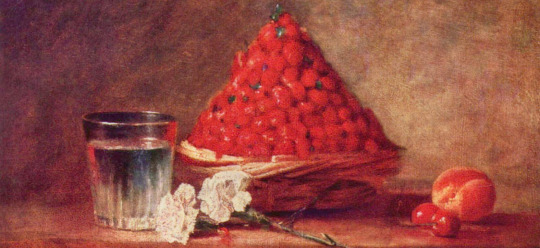
Here is a brief list of some of the foods that have been considered, at some time or other, to have aphrodisiac qualities.
Almond - As well as being the same shape as the vesica piscis, the sacred doorway through which matter emerges into spirit, the almond is a nut and therefore carries the potential for new life.
Aniseed - Falls into the category of seeds. Also aids digestion and sweetens the breath which could explain why the Romans considered it a useful ingredient for seduction.
Apple - Infamous as the fruit that Eve gave to Adam, a symbol of sexual awakening.
Asafetida - (or Asafoetida) This is the ground root of a fennel-like plant. It has a powerful odor, and despite its folk name, Devil’s Dung, it is used as a sexual stimulant in Ayurvedic medicine.
Avocado - The Mexicans called the avocado tree the “testicle tree,” since the fruit dangles down in pairs. The sensual texture of avocado adds to its reputation.

Banana - The banana flower resembles the phallus. Islamic tales say that Adam and Eve covered their sexual parts with banana leaves rather than the more common fig leaves.
Cherry - Sensuously red and juicy, and containing a potent symbol of new life inside the stone. “Popping the cherry” is a slang term for losing one’s virginity.
Chocolate - The melting point of chocolate is the same as that of blood temperature, and so its mouthfeel alone is a sensual experience. Added to this, chocolate contains mood-lifting substances, including phenylethylamine which, when released into the bloodstream, induce feelings of euphoria. Still arguably the most popular food given as a gesture of love. When the 16th century Spanish conquistador Hernán Cortés heard about its reputation as an aphrodisiac, he planted two thousand trees.
Cinnamon - The glorious scent of cinnamon was reputedly used as oil by the Queen of Sheba to help her capture the attention of King Solomon.
Cloves - Because they resemble little phalluses, cloves were considered to enhance male potency. The clove tree was planted to signify the birth of a baby boy in certain parts of Indonesia, the health of the tree reflecting the health of the child as it grew up.

Coriander - Also comes under the category of seeds. Reputed to stimulate appetites of all kinds.
Fennel - The Egyptians who used this as a sexual stimulant cannot have known that it contains plant estrogens that can help balance female hormones. These estrogens also enhance the breasts.
Fig - The plethora of tiny seeds inside the fig is symbolic of fertility, and the moist plumpness of the fruit has a very sensual, feminine element to it.
Ginger and ginseng - Considered to have aphrodisiac powers because of their sharp sensual taste, and because their roots resemble the human form.
Honey - The sweetness of honey made it a rarity for ancient man. It is likely to have given humankind its first instance of alcohol in the form of mead, and its intoxicating effect has distinct aphrodisiac qualities. Bees are themselves symbols of fertility, and honey gives its name to the honeymoon period spent by newlyweds immediately after their marriage.

Mint - A Greek legend says that Menthe, a beautiful nymph, was transformed into the herb because Persephone was jealous of the beautiful scent that captivated her husband, Pluto.
Oyster - The oyster’s resemblance in form, scent, and texture to the female genitalia is renowned. Oysters have had a long history as an aphrodisiac and their reputation is well known. The pearl that is sometimes found inside the oyster was said to increase the powers of arousal, because it resembles the clitoris. Other shellfish, such as mussels, fall into this same category.
Raspberries and strawberries - Libido enhancing because of their color, their many tiny seeds, and their resemblance to nipples.
Star anise - Because of its shape, the star anise was sacred to the Goddess and therefore a potent fertility symbol.
Tomato - Also called the “Love Apple” and is regarded as an aphrodisiac, because of the prolific number of seeds contained within it. However, the name itself is the result of an accidental misinterpretation. Because they were originally a yellow color they were called “Pomo D’or” in Italy, the Apple of Gold. It was also called the “Pomo d’Moro”—the apple of the Moors, referring to its Spanish origins. From here, it was just a slip of the tongue to the French, “Pomme d’Amour,” or Love Apple.
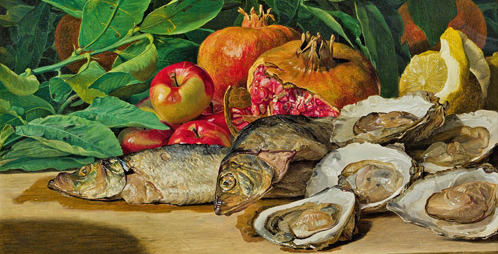
Source ⚜ Writing Notes & References Writing Notes: Aphrodisiacs
#writing reference#food#aphrodisiac#writeblr#art reference#studyblr#literature#writers on tumblr#writing prompt#mythology#spilled ink#dark academia#poetry#love#poets on tumblr#light academia#writing inspiration#creative writing#writing inspo#writing ideas#writing resources
363 notes
·
View notes
Text
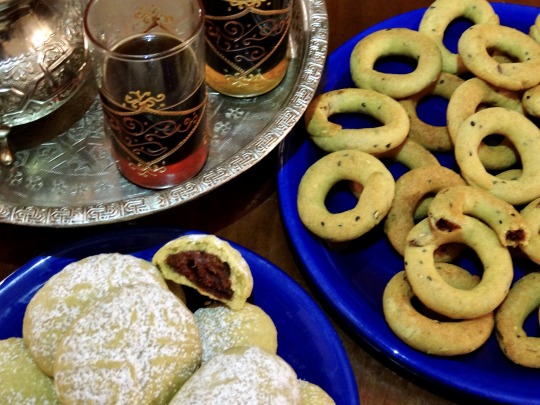
[ID: Two plates of cookies, one oval and topped with powdered sugar, and the others shaped in rings; one cookie is broken in half to show a date filling; two glasses of coffee on a silver tray are in the background. End ID]
معمول فلسطيني / Ma’moul falastini (Palestinian semolina cookies)
Ma’moul (also transliterated “ma’amoul,” “maamoul” and “mamoul”) are sweet pastries made with semolina flour and stuffed with a date, walnut, or pistachio filling. The cookies are made tender and crumbly with the addition of fat in the form of olive oil, butter, or clarified butter (سمن, “samn”); delicate aromatics are added by some combination of fennel, aniseed, mahlab (محلب: ground cherry pits), mastic gum (مستكه, “mistīka”), and cinnamon.
“مَعْمُول” means “made,” “done,” “worked by hand,” or “excellently made” (it is the passive participle of the verb “عَمِلَ” “‘amila,” "to do, make, perform"). Presumably this is because each cookie is individually filled, sealed, and shaped by hand. Though patterned molds known as طوابع (“ṭawābi’,” “stamps”; singular طابع, “ṭābi’”) are sometimes used, the decorations on the surface of the cookies may also be applied by hand with the aid of a pair of small, specialized tongs (ملقط, “milqaṭ”).
Because of their laborious nature, ma’moul are usually made for feast days: they are served and shared for Eid, Easter, and Purim, a welcome reward after the Ramadan or Lenten fasts. For this reason, ma’moul are sometimes called “كَعْك العيد” (“ka’k al-’īd,” “holiday cakes”). Plates of the cookies, whether homemade or store-bought, are passed out and traded between neighbors in a practice that is part community-maintenance, part continuity of tradition, and part friendly competition. This indispensable symbol of celebration will be prepared by the women of a family even if a holiday falls around the time of a death, disaster, or war: Palestinian food writer Laila El-Haddad explains that "For years, we endured our situation by immersing ourselves in cooking, in our routines and the things we could control."
Other names for these cakes exist as well. Date ma’moul–the most common variety in Palestine–may be called كَعْك بعَجْوَة (“ka'k b'ajwa”), “cakes with date paste.” And one particular Palestinian variety of ma’moul, studded with sesame and nigella seeds and formed into a ring, are known as كَعْك أَسَاوِر (“ka'k 'asāwir”), “bracelet cakes.” The thinner dough leads to a cookie that is crisp and brown on the outside, but gives way to a soft, chewy, sweet filling.
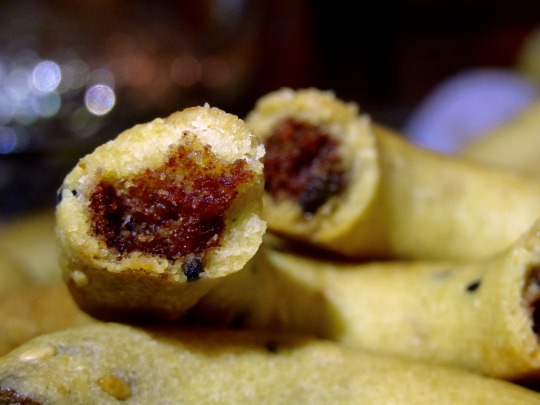
[ID: An extreme close-up on one ka'k al-aswar, broken open to show the date filling; ma'moul and a silver teapot are very out-of-focus in the background. End ID]
History
Various sources claim that ma’moul originated in Egypt, with their ancestor, كحك (kaḥk), appearing in illustrations on Pharaonic-era tombs and temples. The more specific of these claims usually refer to “temples in ancient Thebes and Memphis,” or more particularly to the vizier Rekhmire’s tomb in Thebes, as evidencing the creation of a pastry that is related to modern kahk. One writer attests that this tomb depicts “the servants mix[ing] pure honey with butter on the fire,” then “adding the flour by mixing until obtaining a dough easy to transform into forms” before the shaped cookies were “stuffed with raisins or dried dates and honey.” Another does not mention Rekhmire, but asserts that “18th-dynasty tombs” show “how honey is mixed with butter on fire, after which flour is added, turning the substance into an easily-molded dough. These pieces are then put on slate sheets and put in the oven; others are fried in oil and butter.”
Most of these details seem to be unfounded. Hilary Wilson, summarizing the state of current research on Rekhmire’s tomb, writes that the depicted pastries were delivered as an offering to the Treasury of the Temple of Amun; that they certainly contained ground tiger nuts; that they presumably contained wheat or durum flour, since ground tiger nuts alone would not produce the moldable dough illustrated; that the liquid added to this mixture to form the dough cannot be determined, since the inscription is damaged; that the cakes produced “are clearly triangular and, when cooked are flat enough to be stacked” (any appearance that they are pyramidal or conical being a quirk of ancient Egyptian drawing); that they were shallow-fried, not cooked in an oven; and that honey and dates are depicted at the far left of the scene, but their relationship to the pastries is unclear. There is no evidence of the honey being included in the dough, or the cookies being stuffed with dates; instead, Wilson speculates that “It appears that the cooks are preparing a syrup or puree of dates and honey. It is tempting to think that the cakes or pastries were served [...] with a generous portion of syrup poured over them.” Whether there is any direct lineage between these flat, fried pastries and the stuffed, molded, and baked kahk must also be a matter of speculation. [1]
Another origin claim points to ancient Mesopotamia. James David Audlin speculates that ma’moul are "possibly" the cousins of hamantaschen, both being descended from the molded "kamānu cakes that bore the image of [YHWH’s] goddess wife Inanna [also known as Ishtar or Astarte]" that were made in modern-day Syria. Other claims for Mesopotamia cite qullupu as the inspiration: these cakes are described in the contemporary record as wheat pastries filled with dates or raisins and baked. (Food historian Nawal Nasrallah writes that these cookies, which were offered to Ishtar for the new year festival in spring, may also be an origin point for modern Iraqi كليچة, "kleicha.")
The word "määmoul" had entered the English language as a type of Syrian farina cake by 1896.
In Palestine
From its earliest instantiations, Zionist settlement in Palestine was focused on building farming infrastructure from which Palestinians could be excluded: settlers, incentivized by foreign capital, aimed at creating a separate economy based around farms, agricultural schools, communal settlements, and research institutions that did not employ Arabs (though Arab labor and goods were never entirely cut out in practice).
Zionist agricultural institutes in Palestine had targeted the date as a desirable crop to be self-sufficient in, and a potentially profitable fruit for export, by the 1930s. Ben-Zion Israeli (בנציון ישראלי), Zionist settler and founder of the Kinneret training farm, spoke at a 1939 meeting of the Organization of Fruit Growers (ארגון מגדלי פירות) in the Nahalel (נהלל) agricultural settlement to discuss the future of date palms in the “land of Israel.” He discussed the different climate requirements of Egyptian, Iraqi, and Tunisian cultivars—and which among them seemed “destined” (נועדים) for the Jordan Valley and coastal plains—and laid out his plan to collect saplings from surrounding countries for planting despite their prohibitions against such exports.
In the typical mode of Zionist agriculture discourse, this speech dealt in concepts of cultivation as a means of coming into a predestined ownership over the land; eating food suited for the climate as a means of belonging in the land; and a return to Biblical history as a triumphant reclamation of the land from its supposed neglect and/or over-cultivation by Palestinian Arabs over the past 2,000 years. Israeli opened:
נסתכל לעברה של הארץ, אשר אנו רוצים להחיותה ולחדשה. היא השתבחה ב"שבעה מינים" ואלה עשוה אינטנסיבית וצפופת אוכלוסין. לא רק חיטה ושעורה, כי אם גם עצים הנותנים יבול גדול בעל ערך מזוני רב. בין העצים -- הזית [...] הגפן, התאנה והתמר. לשלושה מהם, לזית, לתאנה ולתמר חטאה התישבותנו שאין היא נאחזת בהם אחיזה ציםכר של ממש ואינה מפתחת אותם דים.
We will look to the past of the land [of Israel], which we want to revive and renew. It excelled in "seven species," and these flourished and became densely populated. Not only wheat and barley, but also trees that give a large and nutritious crop. Among the trees: the olive, [...] the vine, the fig and the date. For three of them, the olive, the fig and the date, it is the sin of our settlement that it does not hold on to them with a strong grip and does not develop them.
He continued to discuss the benefits of adopting the date—not then part of the diet of Jewish settlers—to “health and economy” (בריאות וכלכלה). Not only should the “land of Israel” become self-sufficient (no longer importing dates from Egypt and Iraq), but dates should be grown for export to Europe.
A beginning had already been made in the importation of about 8,000 date palm saplings over the past two decades, of which ¾ (according to Israeli) had been brought by Kibbutz Kinneret, and the remaining ¼ by the settlement department of the Zionist Commission for Palestine (ועד הצירים), by the Mandate government's agriculture department, and by people from Degania Bet kibbutz ('דגניה ב). The majority of these imports did not survive. More recently, 1000 smuggled saplings had been planted in Rachel’s Park (גן רחל), in a nearby government plot, and in various places in the Jordan Valley. Farms and agricultural institutions would need to collaborate in finding farmers to plant dates more widely in the Beit-Sha’an Valley (בקעת בית שאן), and work to make dates take their proper place in the settlements’ economies.
These initial cuttings and their descendents survive in large plantations across “Israel” and the occupied Palestinian territories. Taher Herzallah and Tarek Khaill write that “Palm groves were planted from the Red Sea in the south along the Dead Sea, and as far as the Sea of Galilee up north, which has given the Israeli date industry its nickname ‘the industry of the three seas’” Since Israel occupied the Palestinian West Bank in 1967, it has also established date plantations in its illegal settlements in that portion of the Jordan Valley.” Today, these settlements produce between 40 and 60% of all Israeli dates.
In 2022, Israel exported 67,042 tons of dates worth $330.1 million USD; these numbers have been on a steady rise from 4,909 tons worth $1.2m. in 1993. Palestinian farmers and their children, disappropriated from their land and desperate for income, are brought in to date plantations to work for long hours in hazardous conditions for low pay. Workers are lifted into the date palms by cranes where they work, with no means of descending, until the crane comes to lower them down again at the end of the day. Injuries from falls, pesticides, heat stroke, and date-sorting machinery are common.
Meanwhile, settlers work to curtail and control Palestinian production of dates. The Palestinian population in the West Bank and Gaza is used as a pool of cheap labor and a captive market to purchase Israeli imports, absorb excesses in Israeli goods, stabilize Israeli wages, and make up for market deficits. Thus Palestinian date farmers may be targeted with repressive measures such as water contamination and diversion, destruction of wells, crop destruction, land theft, military orders forbidding the planting of trees, settler attacks, closing of checkpoints and forbidding of exports, and the denial of necessary equipment or the means to make it, in part to ensure that their goods do not compete with those of Israeli farmers in domestic or foreign markets. Leah Temper writes that these repressive measures are part of a pattern whereby Israel tries to “stop [Palestinian] growth in high value crops such as strawberries, avocados and dates, which are considered to be ‘Israeli Specialties’.”
At other times, Palestinian farmers may be ordered to grow certain crops (such as strawberries and dates), and forbidden to grow anything else, when Israeli officials fear falling short of market demand for a certain good. These crops will be exported by Israeli firms, ensuring that the majority of profits do not accrue to Palestinians, and that Palestinians will not have the ability to negotiate or fulfill export contracts themselves. Nevertheless, Palestinian farmers continue to defy these oppressive conditions and produce dates for local consumption and for export. Zuhair al-Manasreh founded date company Nakheel Palestine in 2011, which continues production despite being surrounded by Israeli settlements.
Boycotts of Israeli dates have arisen in response to the conditions imposed on Palestinian farmers and workers. Herzallah and Khaill cite USDA data on the effectiveness of boycott, pressure, and flyering campaigns initiated by groups including American Muslims for Palestine:
Israel’s exports of dates to the US have dropped significantly since 2015. Whereas 10.7 million kilogrammes (23.6 million pounds) of Israeli dates entered the US market in 2015-2016, only 3.1 million kilogrammes (seven million pounds) entered the US market in 2017-2018. The boycott is working and it is having a detrimental effect on the Israeli date industry.
Date products may not be BDS-compliant even if they are not labeled as a product of Israel. Stores may repackage dates under their own label, and exporters may avoid declaring their dates to be a product of Israel, or even falsely label them as a product of Palestine, to avoid boycotts. Purchase California dates, or dates from a known Palestinian exporter such as Zaytoun or Yaffa (not “Jaffa”) dates.
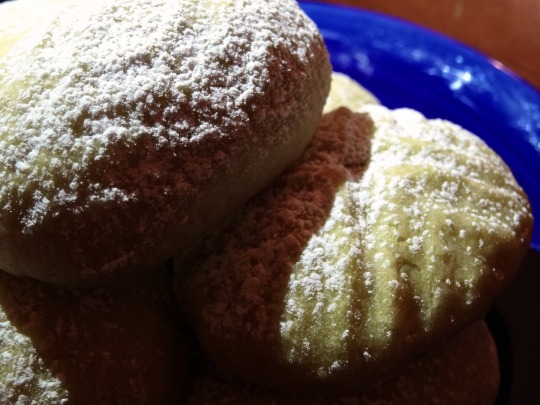
[ID: Close-up of the top of ma'moul, decorated with geometric patterns and covered in powdered sugar, in strong light and shadow. End ID]
Elsewhere
Other efforts to foreground the provenance and political-economic context of dates in a culinary setting have been made by Iraqi Jew Michael Rakowitz, whose store sold ma’moul and date syrup and informed patrons about individual people behind the hazardous transport of date imports from Iraq. Rakowitz says that his project “utilizes food as a point of entry and creates a different platform by which people can enter into conversation.”
[1] Plates from the tomb can be seen in N. de G. Davies, The tomb of Rekh-mi-Rē at Thebes, Vol. II, plates XLVII ff.
Purchase Palestinian dates
Donate to evacuate families from Gaza
Flyer campaign for eSims
Ingredients:
Makes 16 large ma'moul and 32 ka'k al-aswar; or 32 ma'moul; or 64 ka'k al-aswar.
For the dough:
360g (2 1/4 cup) fine semolina flour (سميد ناعم / طحين فرخة)
140g (1 cup + 2 Tbsp) white flour (طحين ابيض)
200g (14 Tbsp) margarine or vegetarian ghee (سمن), or olive oil
2 Tbsp (15g) powdered sugar
1 1/2 Tbsp (10g) dugga ka'k (دقة كعك)
1/2 tsp (2g) instant yeast
About 2/3 cup (190mL) water, divided (use milk if you prefer)
1 tsp toasted sesame seeds (سمسم)
1 tsp toasted nigella seeds (قزحه / حبة البركة)
Using olive oil and water for the fat and liquid in the dough is more of a rural approach to this recipe; ghee and milk (or milk powder) make for a richer cookie.
To make the bracelets easy to shape, I call for the inclusion of 1 part white flour for every 2 parts semolina (by volume). If you are only making molded cookies and like the texture of semolina flour, you can use all semolina flour; or vary the ratio as you like. Semolina flour will require more added liquid than white flour does.
For the filling:
500g pitted Madjoul dates (تمر المجهول), preferably Palestinian; or date paste
2 Tbsp oil or softened margarine
3/4 tsp dugga ka'k (دقة كعك)
3/4 tsp ground cinnamon
5 green cardamom pods, toasted, skins removed and ground; or 1/4 tsp ground cardamom
Small chunk nutmeg, toasted and ground, or 1/4 tsp ground nutmeg
10 whole cloves, toasted and ground, or 1/4 tsp ground cloves
The filling may be spiced any way you wish. Some recipes call for solely dugga ka'k (or fennel and aniseed, its main components); some for a mixture of cinnamon, cardamom, nutmeg, and/or cloves; and some for both. This recipe gives an even balance between the pungency of fennel and aniseed and the sweet spiciness of cinnamon and cloves.
Palestinian date brands include Ziyad, Zaytoun, Hasan, and Jawadir. Palestinian dates can also be purchased from Equal Exchange. You can find them online or at a local halal market. Note that an origin listed as "West Bank" does not indicate that a date company is not Israeli, as it may be based in a settlement. Avoid King Solomon, Jordan River, Mehadrin, MTex, Edom, Carmel Agrexco, Arava, and anything marked “exported by Hadiklaim”. Also avoid supermarket brands, as the origin of the dates may not be clearly marked or may be falsified to avoid boycots.
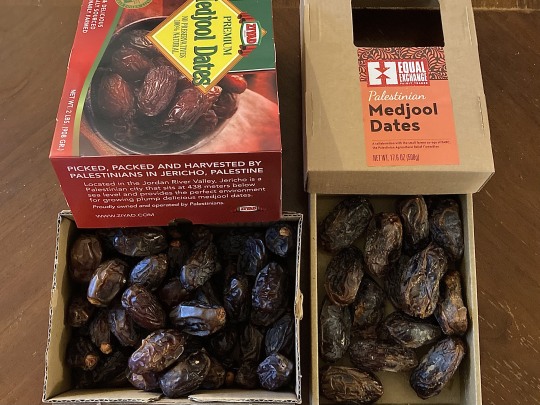
Instructions:
For the dough:
1. Melt margarine in a microwave or saucepan. Measure flours into a large mixing bowl and pour in margarine; mix thoroughly to combine. Rub flours between your hands for a few minutes to coat the grains in margarine. The texture should resemble that of coarse sad. Refrigerate the mixture overnight, or for up to 3 days.

2. Add dry ingredients to dough. If making both molded ma'moul and ka'k al-aswar, split the dough in half and add sesame and nigella seeds to one bowl.
3. Add water to each dough until you get a smooth dough that does not crack apart when formed into a ball and pressed. Press until combined and smooth, but do not over-knead—we don't want a bready texture. Set aside to rest while you make the filling.
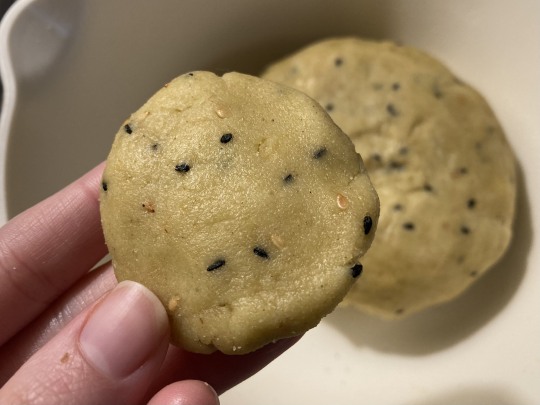
For the filling:
1. Pit dates and check the interiors for mold. Grind all ingredients to a paste in a food processor. You may need to add a teaspoon of water, depending on the consistency of your dates.
To shape the cookies:
Divide the filling in half. One half will be used for the ma'moul, and the other half for the bracelets.
For the ma'moul:
1. With wet hands, pinch off date filling into small chunks about the size of a walnut (13-16g each, depending on the size of your mold)—or roll filling into a long log and divide into 16-20 even pieces with a dough scraper. Roll each piece of filling into a ball between your palms.
2. Divide the dough (the half without seeds) into the same number of balls as you have balls of filling, either using a kitchen scale or rolling into a log and cutting.
3. Form the dough into a cup shape. Place a ball of filling in the center, and fold the edges over to seal. Press the dough into a floured ma'moul mold to shape, then firmly tap the tip of the mold on your work surface to release; or, use a pair of spiked tweezers or a fork to add decorative designs by hand.

4. Repeat until all the the dough and filling has been used, covering the dough you're not working with to keep it from drying out. Place each cookie on a prepared baking sheet.
For the ka'k al-aswar:
1. With wet hands, divide the date filling into about 32 pieces (of about 8g each); they should each roll into a small log about the size of your pinkie finger.
2. Divide the dough (the half with the seeds) into as many pieces as you have date logs.
3. Take a ball of dough and flatten it into a thin rectangle a tiny bit longer than your date log, and about 3 times as wide. Place the date log in the center, then pull the top and bottom edges over the log and press to seal. Seal the ends.
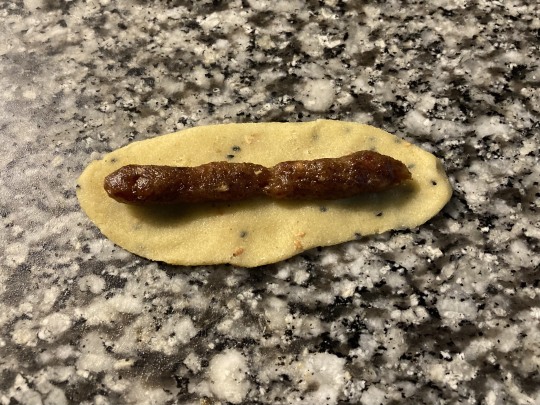
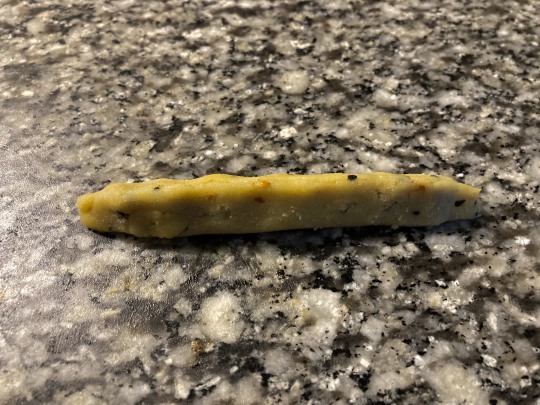
4. Roll the dough log out again to produce a thin, long rope a little bit thinner at the very ends than at the center. Press one side of the rope over the other to form a circle and press to seal.
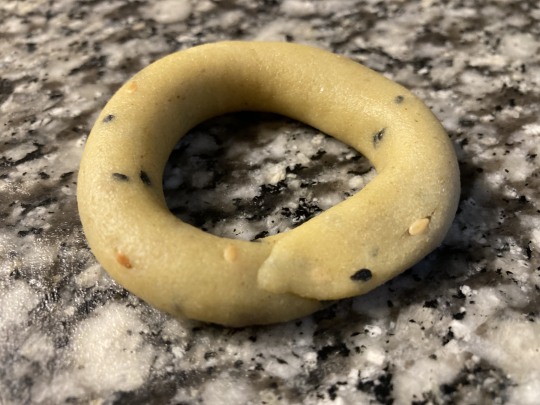
5. Repeat until all the the dough and filling has been used, covering the dough you're not working with to keep it from drying out. Place each cookie on a prepared baking sheet.
To bake:
1. Bake ma'moul at 350 °F (175 °C) in the center of the oven for about 20 minutes, until very lightly golden brown. They will continue to firm up as they cool.
2. Increase oven heat to 400 °F (205 °C) and bake ka'k al-aswar in the top third of the oven for about 20 minutes, until golden brown.
Sprinkle cookies with powdered sugar, if desired. Store in an airtight container and serve with tea or coffee, or give to friends and neighbors.
394 notes
·
View notes
Text

Smoky Shredded Tofu Breakfast Sandwich (Vegan)
#vegan#breakfast#sandwiches#dill#tofu#spinach#parsley#chives#avocado#garlic#lime#paprika#coriander#fennel seeds#allspice#tamari#liquid smoke#white pepper#cornstarch#avocado oil#sea salt
79 notes
·
View notes
Text
Smoky Lentil Soup (Vegan)

Fragrant and heart-warming, this comforting Smoky Lentil Soup is the ideal dinner on a frosty night. Happy Monday!
Ingredients (serve 4):
2 tablespoons olive oil
1/2 teaspoon fennel seeds
1/2 teaspoon dried oregano
1 onion
1 heaped teaspoon smoked paprika
1/4 teaspoon ground chilli or Cayenne Pepper
1 garlic clove, minced
2 cups cooked or tinned Puy Green Lentils
3 ripe Tomatoes
1 teaspoon coarse sea salt
1/2 teaspoon freshly cracked black pepper
2 tablespoons Modena Balsamic Vinegar
1/2 litre/2 cups water
1 tablespoon demerara sugar
Heat olive oil in a large pot over a medium flame.
Once hot, add fennel seeds and oregano, and fry, a couple of minutes.
Peel and finely chop onion. Add to the pot, and cook, another couple of minutes until softened.
Stir in smoked paprika, ground chilli and minced garlic, and fry, one minute more.
Increase heat to medium-high, and stir in cooked Puy Green Lentils, coating in oil, herbs and spices.
Roughly chop Tomatoes, and stir them, along with their juice, into the pot. Season with coarse sea salt and black pepper, and cover with the lid. Cook, for about 5 minutes until Tomatoes collapse and release more of their juice.
Deglaze with Balsamic Vinegar. Cook out, 1 minute.
Finally, stir in water, and bring to the boil. Reduce heat to medium-low, cover with the lid, and simmer, about 20 minutes more.
Stir in demerara sugar, until completely dissolved.
Serve Smoky Lentil Soup hot, with crusty Sourdough.
#Recipe#Food#Smoky Lentil Soup#Smoky Lentil Soup recipe#Lentil Soup#Lentil Soup recipe#Lentils#Puy Lentils#Puy Green Lentils#Lentilles Vertes du Puy#Olive Oil#Fennel Seeds#Oregano#Dried Oregano#Onion#Paprika#Smoked Paprika#Ground Chilli#Chilli#Garlic#Tomatoes#Marmande Tomatoes#Balsamic Vinegar#Modena Balsamic Vinegar#Water#Demerara Sugar#Soup#Soup recipe#Soup and Stew#Vegan Soup
0 notes